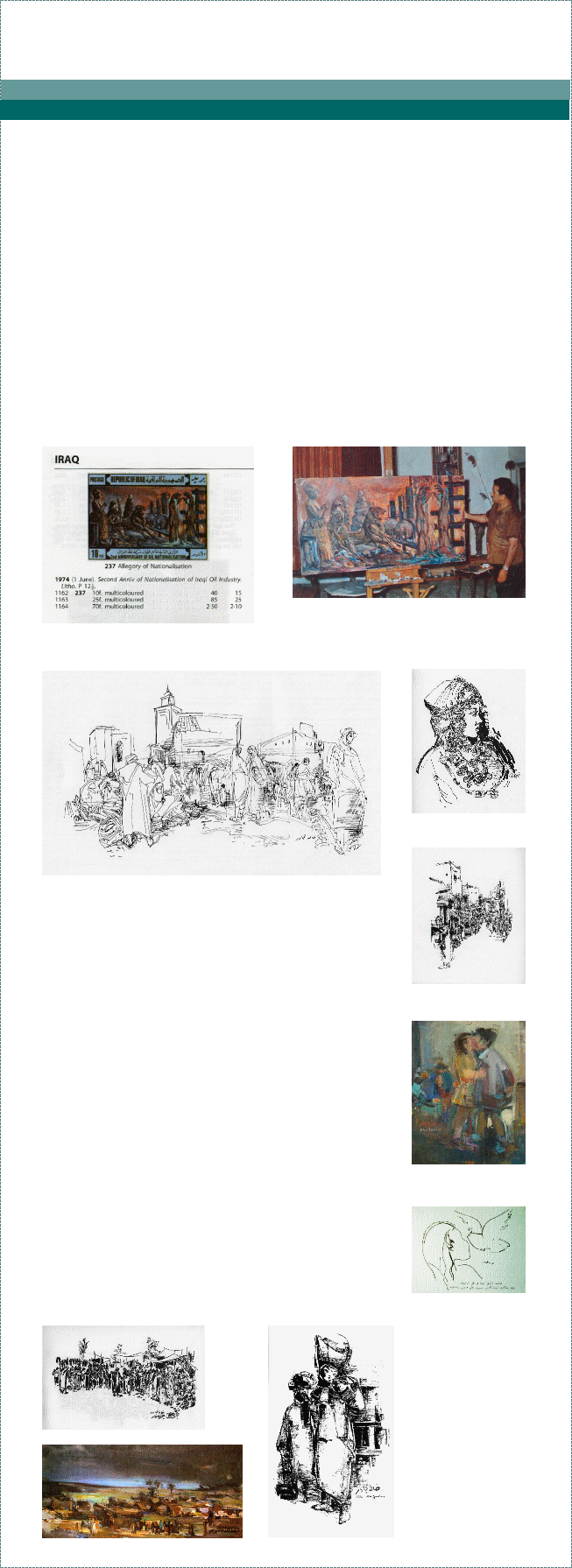
Introduction - 1 - 2 - 3 - 4 | CV - The Artist - The Professor - The Scholar
2. The Precursor of Contemporary Expressionist Art in Iraq
His painting titled ‘Nationalization’ reflects a symbolic realism, which creates an organic link between the rich heritage of ancient Mesopotamia and the present time. Al-Jadir produced his famous work, ‘Nationalization’, in celebration of the declaration by the State of Iraq of the nationalization of its oil reserves in 1972. His masterpiece won him a prize in recognition from the head of State of the time.
The artistic value of this painting resides in its composition which combines symbols inspired from ancient Mesopotamian cultures, namely the Sumerian, Assyrian, Al-Hadhar and the Abbasid. It depicts the Sumerian philosopher Dudu standing on his feet to salute the nationalization initiative, while the lion symbolized power. Also, the artist referred to the flourishing Al-Hadhar and Abbasid cultures by bringing the icons of the eagle, Mace and the spiral minaret (Al-Malwiya).
The painting ‘Nationalization’ was reproduced into a five Dinar fiscal stamp carrying the date of June 1st, 1972 beside the wording ‘Republic of Iraq’. It was also reproduced into a stamp which decorated Iraqi passports, and which displayed the inscription ‘Allegory of Nationalism’.
Khalid Al-Jadir
© Saad Al-Jadir 2011
Stanley Gibbons – Stamp Catalogue Part 19
Middle East - 6th Edition 2005, Page 104
As far as Al-Jadir’s sketches are concerned, the Iraqi poet, Ahmad Al-Mahdaoui, relates that Al-Jadir was the painter of the An-Nab’a’ (the spring) magazine in 1937 in Baghdad where he published sketches executed with Chinese ink and bamboo pens. Al-Jadir’s sketch-work was sustained along with oil painting all throughout his life, first as an expressionist form of painting itself and second as a base work for a painting. Iraqi art critique, Hussein Al- Hilali, wrote that Al-Jadir’s sketches had become a primordial base for the art of painting in Iraq and a style twined with his name, thus introducing a new rule in sketching in both Iraq and the Arab world.
The basis of Khalid Al-Jadir's artistic vision resides in his ability to derive inspiration from artistic substance originating in the present and the past, whether it is of a local or international source. To achieve this, he successfully combined cultural elements from ancient Sumerian, Babylonian, and Assyrian heritages, as well as from the Islamic culture and modern European impressionist and expressionist influences, added to his deep knowledge of the history of art.
Khalid Al-Jadir was naturally gifted for artistic creation and he worked throughout the years of his life on the betterment of this gift. The lines of his brush and knife in their, quietude as well as in their free, vivid and quick movement were strong and violent. He had an ability to physically blend the subject matter of his art work through an original form of expression and fine technique.
Artist and doctor of medicine ‘Ala’ Basheer describes the work of Khalid Al-Jadir as being characterized by the intense feelings conveyed by the rebellious lines and the colours full of life that strive to move on the space of the painted surface like an increased heartbeat at the sight of one’s beloved.
In Al-Jadir's work, nature is a central theme; it almost takes the shape of poetry and music. Al-Jadir loaded his work with his own feelings and passionate love for nature, and it acts as a physical and spiritual medium between the beauty of nature and the viewer.